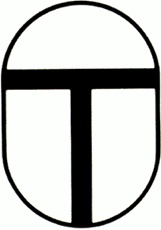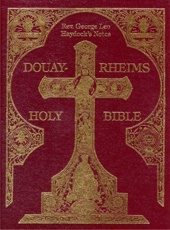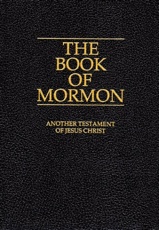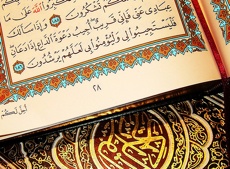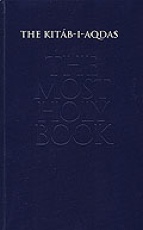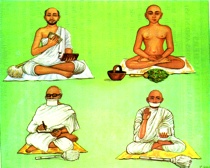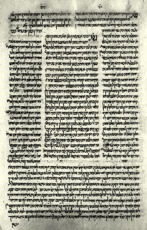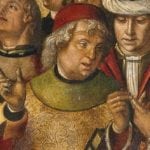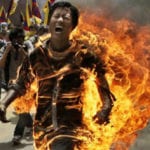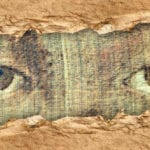 The Arts
The Arts  The Arts
The Arts  Crime
Crime 10 Fascinating Facts about Rikers Island
 Pop Culture
Pop Culture 10 Things You Might Not Know about Dracula
 Weird Stuff
Weird Stuff 10 Everyday Activities That Were Once Considered Illegal
 History
History Ten of History’s Hidden Secrets: Stories 99% Don’t Know About
 Movies and TV
Movies and TV 10 Actors Who Infamously Stormed Off Set While Filming
 Food
Food 10 Foods That Have Alleged Occult Powers
 Sport
Sport 10 Lesser-Known Multi-Sport Alternatives to the Olympics
 Humans
Humans 10 Real Life Versions of Famous Superheroes
 Gaming
Gaming 10 Overused Game Villains
 The Arts
The Arts 10 Masterpieces Plucked from the Artist’s Subconscious
 Crime
Crime 10 Fascinating Facts about Rikers Island
 Pop Culture
Pop Culture 10 Things You Might Not Know about Dracula
Who's Behind Listverse?

Jamie Frater
Head Editor
Jamie founded Listverse due to an insatiable desire to share fascinating, obscure, and bizarre facts. He has been a guest speaker on numerous national radio and television stations and is a five time published author.
More About Us Weird Stuff
Weird Stuff 10 Everyday Activities That Were Once Considered Illegal
 History
History Ten of History’s Hidden Secrets: Stories 99% Don’t Know About
 Movies and TV
Movies and TV 10 Actors Who Infamously Stormed Off Set While Filming
 Food
Food 10 Foods That Have Alleged Occult Powers
 Sport
Sport 10 Lesser-Known Multi-Sport Alternatives to the Olympics
 Humans
Humans 10 Real Life Versions of Famous Superheroes
 Gaming
Gaming 10 Overused Game Villains
10 Religious Scriptures Explained
There have been a number of lists on the site that have discussed various religions, so it seems appropriate to discuss the religious literature of some of those religions. Therefore, here is a list of religious scriptures explained. This list is not exhaustive because some of the religions mentioned have more than one scriptural text. I have selected one main text from each.
1. OT Levels The Church of Scientology
Scientology, the religion founded by L Ron Hubbard, uses a series of documents that he wrote as their primary scriptures. One can dispute the title of “scripture” in that they are more a series of directions and tests to help members attain the higher goal of clearing their bodies of creatures placed there by the evil warlord Xenu. Having reached a state of clear, members of the church pay to move on to the OT levels (Operating Thetan). These texts are very difficult to come by, but from time to time they make their way in to the public eye (either by becoming a part of the public record, or through members releasing them).
The Church of Scientology claims that Hubbard wrote levels up to 15, but so far only the first 8 have been released. They are numbered with roman numerals and are ranked in levels: level I, level II … level VIII. After moving through the levels, one eventually reaches the level of Cleared Theta Clear – a super-human state. Hubbard describes it thus:
“A thetan who is completely rehabilitated and can do everything a thetan should do, such as move MEST [matter, energy, space, and time] and control others from a distance, or create his own universe; a person who is able to create his own universe or, living in the MEST universe is able to create illusions perceivable by others at will, to handle mest universe objects without mechanical means and to have and feel no need of bodies or even the MEST universe to keep himself and his friends interested in existence”.
Have a marvelous family movie night with The Bible: The Epic Miniseries at Amazon.com!
2. The Bible Christianity
The Bible is the religious book used by Christians. It is comprised of two books – the first, the Old Testament, is also a part of the Jewish scriptures. The Old Testament is made up of 45 books ordered according to the Septuagint (the Greek version of the Bible used at the time of Christ), though in the 1500’s protestants reduced the number by 7 books as they were not found in Hebrew versions of the Bible (Tobit, Judith, Wisdom, Sirach, Baruch, and First and Second Maccabees) and parts of books (Esther 10:4-16:24, and Daniel 3:24-90; 13:1-14:42). The Old Testament describes the history and rules of the Jews before the time of Christ. It also includes the Psalms – a set of songs – that are attributed to King David. Probably the most famous of these is “The Lord is my Shepherd”. There are many Christian sects (fundamentalists) that consider the Bible to be true in every respect, but the majority of Christians do not believe this. This can cause difficulties when looking at the verses in the Old Testament that prescribe stoning to death for certain minor crimes.
1 In the beginning was the Word, and the Word was with God, and the Word was God. 2 The same was in the beginning with God. 3 All things were made by him: and without him was made nothing that was made. 4 In him was life, and the life was the light of men. 5 And the light shineth in darkness, and the darkness did not comprehend it. St John 1:1-5, New Testament
The books of the New Testament are 27 in number and all Christian religions have the same canon. The New Testament includes the life of Christ as well as the movements and teachings of the Church and the Apostles in the first years after the death of Jesus. The life of Christ is described primarily in the four Gospels: Matthew, Mark, Luke, and John. Christians consider the Bible to be the Word of God and believe it contains no errors.
It is worth noting that Catholics and the Orthodox consider the Sacred Traditions (with a capital ‘T’) of the Church to be of equal authority to the Bible; in fact some may say higher, as the Bible itself is an out-flowing of that Tradition.
View the complete Bible here
3. The Book of Mormon Mormonism
The Book of Mormon is a religious book considered by the Church of Jesus Christ of Latter Day Saints (and its split offs) to be on an equal level with the Christian Bible as God’s word. It was allegedly found by Joseph Smith (founder of the Mormons) when an angel directed him to a hill in which they were buried. Smith claimed they were written on solid Gold tablets and that he was given special tools to translate the ancient language. In addition to this book, Mormons also consider some other texts as scriptural, such as the Book of Abraham (a translation of some Egyptian Hieroglyphics).
10 Behold, I, Abinadom, am the son of Chemish. Behold, it came to pass that I saw much war and contention between my people, the Nephites, and the Lamanites; and I, with my own sword, have taken the lives of many of the Lamanites in the defence of my brethren. 11 And behold, the arecord of this people is engraven upon plates which is had by the bkings, according to the generations; and I know of no revelation save that which has been written, neither prophecy; wherefore, that which is sufficient is written. And I make an end. Omni, 1:10-11
The crowning glory of the Book of Mormon is the description of the visitation of Christ to an ancient American people called Nephites which it claims occured around 34 AD. There are fifteen books of the Book of Mormon which comprise the writings of various prophets and descriptions of the history of the Nephites and Lamanites.
View the Book of Mormon here
4. The Quran Islam
Muslims believe the Qur’an to be the book of divine guidance and direction for mankind and consider the text in its original Arabic to be the literal word of “Allah” (God), revealed to Muhammad over a period of twenty-three years and view the Qur’an as God’s final revelation to humanity.
The Qur’an consists of 114 chapters of varying lengths, each known as a sura. Each chapter possesses a title: usually a word mentioned within the chapter itself. In general the longer chapters appear earlier in the Quran, while the shorter ones appear later. As such, the arrangement is not connected to the sequence of revelation
38 The day when the Spirit and the angels stand in ranks;a none shall speak except he whom the Beneficent permits and he speaks aright. 39 That is the True Day, so whoever desires may take refuge with his Lord. 40 Truly We warn you of a chastisement near at handa— the day when man will see what his hands have sent before, and the disbeliever will say: O would that I were dust! Al-Naba’ 38-40
Muslims regard the Qur’?n as the culmination of a series of divine messages that started with those revealed to Adam — regarded, in Islam, as the first prophet — and including the Suhuf-i-Ibrahim (Scrolls of Abraham), the Tawrat (Torah), the Zabur (Psalms), and the Injil (Gospel). The aforementioned books are recognized in the Qur’?n, and the Qur’anic text assumes familiarity with many events from Jewish and Christian scriptures, retelling some of these events in distinctive ways, and referring obliquely to others.
View the Quran here
5. Tripi?aka Buddhism
Many different versions of the Budhist canon have existed throughout the Buddhist world, containing an enormous variety of texts. The oldest and most widely-known version is the P?li Canon of the Therav?da school. The Tripitaka writings of early schools of Buddhism, which were originally memorized and recited orally by disciples, fall into three general categories and are traditionally classified in three baskets (tri-pi?aka). The commonest order is the following: Vinaya Pi?aka (Code of Ethics), S?tra Pi?aka (accounts of Buddha’s teachings), Abhidharma Pi?aka (this differs from version to version).
2. People were annoyed, murmured, and became angry, saying, `How can the Sakyaputtiya samaõas go on their travels alike during winter, summer, and the rainy season? They crush the green herbs, they hurt vegetable life, they destroy the life of many small living things. Shall the ascetics who belong to titthiya schools, whose Doctrine is ill preached, retire during the rainy season and arrange places for themselves to live in? Shall the birds make their nests on the summits of the trees, and retire during the rainy season, and arrange themselves places to live in; and yet the Sakyaputtiya samaõas go on their travels alike during winter, summer, and the rainy season, crushing the green herbs, hunting vegetable life, and destroying the life of many small things?’ Third Khandhaka
The Chinese form of Tripi?aka, “Sanzang”, was sometimes used as an honorary title for a Buddhist monk who has mastered all the Tripi?aka canons, most notably in the case of the Tang Dynasty monk Xuanzang, whose pilgrimage to India to study and bring Buddhist text back to China was portrayed in the novel Journey to the West as “Tang Sanzang”.
View the Tripi?aka here
Get free shipping, thousands of movies, and millions of streaming songs with a FREE trial of Amazon Prime at Amazon.com!
6. Guru Granth Sahib Sikhism
The Shri Guru Granth Sahib is the 11th Guru of Sikhism, the holy book of Sikhism, which is revered as a living Guru by the Sikhs. The Shri Guru Granth Sahib became Guru of the Sikhs and successor to Guru Gobind Singh on October 1708, when the 10th Guru of Sikhism made the Guru Granth Sahib the 11th and final eternal Guru of Sikhism. The Shri Guru Granth Sahib was written and compiled by the Sikh Gurus and contains all their knowledge, wisdom and every knowledge of Sikhism.
O Nanak, if I had hundreds of thousands of stacks of paper, and if I were to read and recite and embrace love for the Lord,
and if ink were never to fail me, and if my pen were able to move like the wind -even so, I could not estimate Your Value. How can I describe the Greatness of Your Name? Page 15
The Guru Granth Sahib is the only religious book in the world which contains holy ideas and thoughts of great saints from other religion, castes, and ethics. Some of these are Saint Kabir, Tulsidas, Guru Ravidas (who was considered to be a low caste shudra at his time of living but his holy thoughts and ideas got place in the holy book). The holy text comprises over 5000 Shabhads or hymns which are poetically constructed; and set to classical form of music rendition Ragas; can be set to predetermined musical Talas (rhythmic beats) and have a definite message for the whole of humanity.
View the Sri Guru Granth Sahib here
7. Kitáb-i-Aqdas Bahá’í Faith
The Kitáb-i-Aqdas is a central book of the Bahá’í Faith written by Bahá’u’lláh, the founder of the religion. The work was written in Arabic under the Arabic title al-Kitáb al-Aqdas, but it is commonly referred to by its Persian title, Kitáb-i-Aqdas, which was given to the work by Bahá’u’lláh himself. It is sometimes also referred to as “the Aqdas”, “the Most Holy Book”, “the Book of Laws” and occasionally “the Book of Aqdas”.
It hath been ordained that every believer in God, the Lord of Judgement, shall, each day, having washed his hands and then his face, seat himself and, turning unto God, repeat “&Allah-u-Abha” ninety-five times. Such was the decree of the Maker of the Heavens when, with majesty and power, He established Himself upon the thrones of His Names. Perform ye, likewise, ablutions for the Obligatory Prayer; this is the command of God, the Incomparable, the Unrestrained. Text 18
It is usually stated that the book was completed around 1873, although there is evidence to suggest that at least some of the work was written earlier [1]. Bahá’u’lláh had manuscript copies sent to Bahá’ís in Iran some years after the revelation of the Kitáb-i-Aqdas, and in the year 1308 A.H. (1890-91 A.D.), he arranged for the publication of the original Arabic text of the book in Bombay. It is not just a ‘book of laws’: much of the content deals with other matters, notably ethical exhortations and addresses to various individuals, groups, and places. The Kitáb-i-Aqdas also discusses the establishment of Bahá’í administrative institutions, Bahá’í religious practices, laws of personal status, criminal law, ethical exhortations, social principles, miscellaneous laws and abrogations, and prophecies.
View the Kitáb-i-Aqdas here
8. Ägams Jainism
In most of the religions, there is one main scripture book. Hinduism has Gita and 4 Vedas, Christians have the Bible, Muslims have Koran, Persians have Avesta, and Sikhs have Guru Granth Sahib, and Buddhists have 3 Pitikäs. Likewise, Jains also have their own scriptures called Ägams, also called the Jain Shrut. Jains are people of books, they do not have one main scripture book but they have many. The teachings of Tirthankar to his enlighten principal disciples, called Ganadhars was first composed in fourteen Purvas and then in twelve Ang-Pravishtha-Ägams (an `Ang’ being a `limb’) by Ganadhars themselves. All Purvas are included in one part of the twelfth Ang, called Drastiväd.
10. In the hells the mere touch of the ground causes so much of pain as would not have been caused even by the sting of a thousand of scorpions. There flow the rivers of the pus and blood, full of swamp of worms, and they burn the body (of the inhabitants of the hells). 11. There (in the hells) are Semara trees the edges of whose leaves are (as sharp) as the blade of the sword, and they tear the limbs (of the inhabitants) like a sword. In the hells the climate is so (intensely) cold and hot that a lump of iron, as big as the mountain Meru, may get melted. Chhahdhala Dhala 1:10-11
The composition of scripture has a specific purpose of showing the listener the path of everlasting happiness and liberation. The Ägam Sutras teach the eternal truth about conduct, equanimity, universal affection and friendship, and the eternal truths on thinking, namely, the principle of relativity, principle of non-one-sided-ness and many spiritual things including great reverence for all forms of life, soul, karma, universe, strict codes of asceticism, rules for householders, compassion, nonviolence, non-possessiveness. In addition to the twelve Ang-pravishtha works composed by the Ganadhars, other canonical literature (Ang-bähya-Ägams) which composed by Stathviras or elder monks are also included as part of the Jain Ägams.
Jains believe that ‘Ang-Pravishtha-Agams’ were at all times in the past, are in the present, and will be at all times in the future. They are eternal, firm, permanent, non-destructive, non-decaying and everlasting.
View the Ägams here
9. Bhagavad Gita Hinduism
The Bhagavad Gita (“Song of God”) is a Sanskrit text from the Bhishma Parva of the Mahabharata epic. Due to differences in recensions they may be numbered in the full text of the Mahabharata as chapters 6.25 – 42 or as chapters 6.23-40. According to the recension of the Gita commented on by Shankaracharya, the number of verses is 700, but there is evidence to show that some old manuscripts had 745 verses. Krishna, as the speaker of the Bhagavad Gita, is referred to within as Bhagavan (the divine one), and the verses themselves, using the range and style of Sanskrit meter (chandas) with similes and metaphors, are written in a poetic form that is traditionally chanted; hence the title, which translates to “the Song of the Divine One”. The Bhagavad Gita is revered as sacred by the majority of Hindu traditions, and especially so by followers of Krishna. It is commonly referred to as The Gita.
‘The yogi is superior to the ascetics, is also thought to be superior to the knowledgeable, and the yogi is superior to the active. Therefore, be a yogi, Arjuna. Of all these yogis, the one going to me with inner soul full of faith, who loves me, this one is thought by me to be most united.’
The content of the text is a conversation between Krishna and Arjuna taking place on the battlefield of Kurukshetra just prior to the start of a climactic war. Responding to Arjuna’s confusion and moral dilemma, Krishna explains to Arjuna his duties as a warrior and Prince and elaborates on a number of different Yogic and Vedantic philosophies, with examples and analogies. This has led to the Gita often being described as a concise guide to Hindu philosophy and also as a practical, self-contained guide to life. During the discourse, Krishna reveals his identity as the Supreme Being Himself (Bhagavan), blessing Arjuna with an awe-inspiring glimpse of His divine absolute form.
View the Bhagavad Gita here
10. The Talmud Judaism
In addition to the Old Testament, Jews consider the Talmud to be one of the most important texts in the religion. The Talmud is a record of rabbinic discussions pertaining to Jewish law, ethics, customs and history. The Talmud has two components: the Mishnah (c. 200 AD), the first written compendium of Judaism’s Oral Law; and the Gemara (c. 500 AD), a discussion of the Mishnah and related Tannaitic writings that often ventures onto other subjects and expounds broadly on the Tanakh. The Gemara is the basis for all codes of rabbinic law and is much quoted in other rabbinic literature.
R. Johanan used to say: A betrothed young girl, who is the daughter of a priest, is to be stoned if she has sinned; but according to R. Simeon, she must be burned. And the same is the case if she had sinned with her father. (Although, if such a case happened with a commoner, burning is applied, nevertheless she is to be stoned, according to the rabbis); as according to their theory stoning is more rigorous, and there is a rule that he who is guilty of two crimes liable to capital punishment is to be executed with the more rigorous one. And according to R. Simeon, that burning is more rigorous, she is to be put to death by that. And where do we find R. Simeon saying so? Sanhedron
Much of the Gemara consists of legal analysis. The starting point for the analysis is usually a legal statement found in a Mishnah. The statement is then analyzed and compared with other statements in a dialectical exchange between two (frequently anonymous and sometimes metaphorical) disputants, termed the makshan (questioner) and tartzan (answerer).
View the Talmud here
Sources: Wikipedia
Technorati Tags: religion, scriptures
